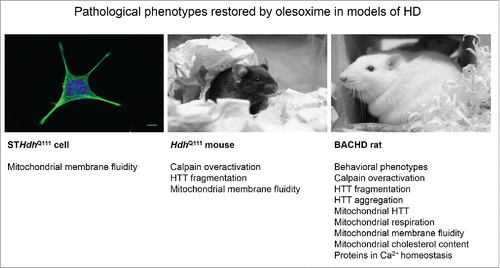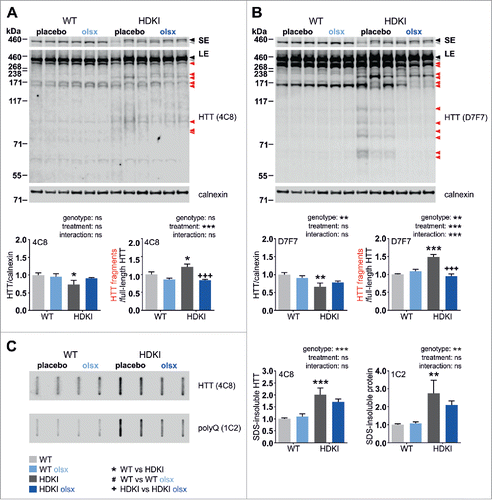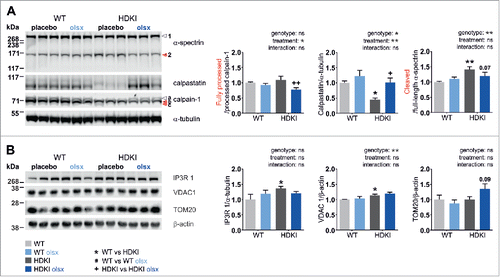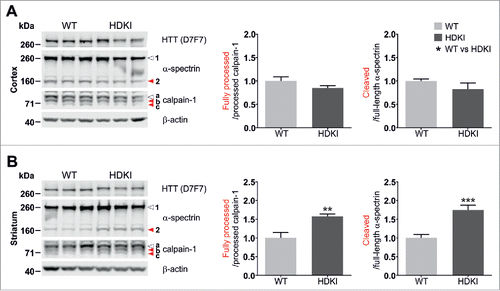Figures & data
Figure 1. Overview of pathological phenotypes restored by olesoxime in models of HD. The effect of olesoxime on pathological phenotypes has been studied in 3 models of HD: the STHdhQ111 cell line, the HdhQ111 knock-in mouse and the BACHD rat.

Figure 2. Olesoxime treatment reduces mHTT fragmentation in HdhQ111 knock-in mice. Effects of olesoxime on HTT fragmentation were analyzed by western blotting of half brain lysates from 3 months old wild type (WT) and heterozygous HdhQ111 knock-in mice (HDKI) receiving placebo or olesoxime-loaded diet (olsx). Full-length and fragment forms of HTT were assessed using the HTT-specific antibodies 4C8 (A) and D7F7 (B). Black arrowheads: full-length mHTT, gray arrowhead: full-length HTT, red arrowheads: HTT fragments, calnexin: loading control. SE: short exposure; LE: long exposure. (C) SDS-insoluble proteins were trapped on a nitrocellulose membrane and probed with the HTT-specific antibody 4C8 or the polyQ-specific antibody 1C2 to quantify the amount of aggregated HTT. Data were analyzed using 2-way ANOVA and Fisher LSD posttest; */#/+: P < 0.05; **/##/++: P ≤ 0.01 and ***/###/+++: P ≤ 0.001.

Figure 3. The calpain-suppressing effects of olesoxime are replicated in HdhQ111 knock-in mice. The calpain-suppressing effects of olesoxime were investigated by protein gel blot analysis of half brain lysate from 3 months old wild type (WT) and heterozygous HdhQ111 knock-in mice (HDKI) receiving placebo or olesoxime-loaded diet (olsx). (A) Calpain activation was assessed based on the processing of calpain-1, protein levels of the endogenous calpain inhibitor calpastatin and the cleavage of the calpain substrate α-spectrin. Arrowhead 1: full-length α-spectrin, arrowhead 2: α-spectrin fragment, arrowhead a: full-length calpain-1, arrowhead b: processed calpain-1, arrowhead c: fully processed calpain-1 (active calpain-1 refers to the ratio c/b), α-tubulin: loading control. (B) Expression levels of the endoplasmic reticulum Ca2+ transporter IP3R 1, outer mitochondrial membrane channel VDAC 1 and mitochondrial import receptor subunit TOM20 were assayed. β-actin: loading control. Data were analyzed using 2-way ANOVA and Fisher LSD posttest; */#/+: P < 0.05; **/##/++: P ≤ 0.01 and ***/###/+++: P ≤ 0.001.

Figure 4. Calpain overactivation is restricted to the striatum in 6 months old HdhQ111 knock-in mice. Calpain activation was assessed by western blot analysis of cortical (A) and striatal (B) lysates from 6 months old wild type (WT) and homozygous HdhQ111 knock-in mice (HDKI), based on the processing of calpain-1 and the cleavage of its substrate α-spectrin. Arrowhead 1: full-length α-spectrin, arrowhead 2: α-spectrin fragment, arrowhead a: full-length calpain-1, arrowhead b: processed calpain-1, arrowhead c: fully processed calpain-1 (active calpain-1 refers to the ratio c/b), β-actin: loading control. Data were analyzed using unpaired Student's t-test; */#/+: P < 0.05; **: P ≤ 0.01 and ***: P ≤ 0.001.

